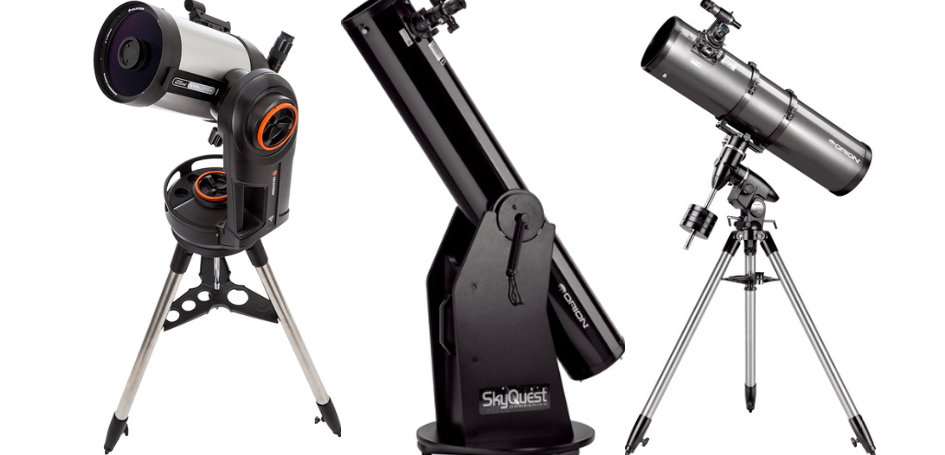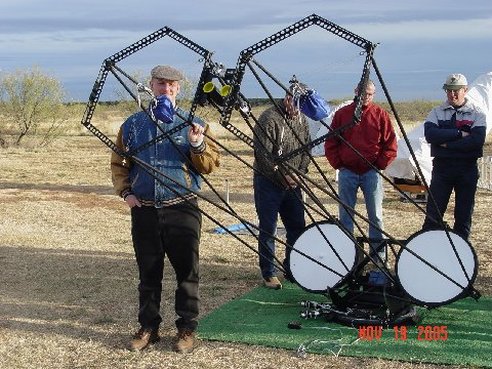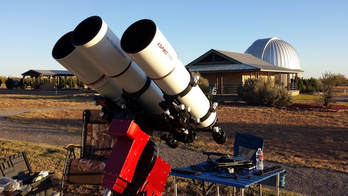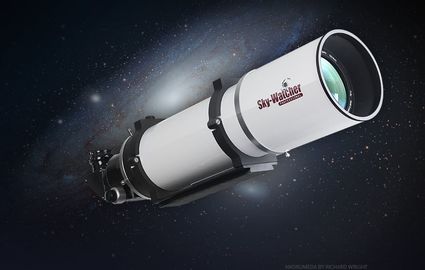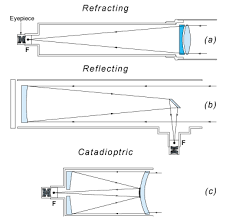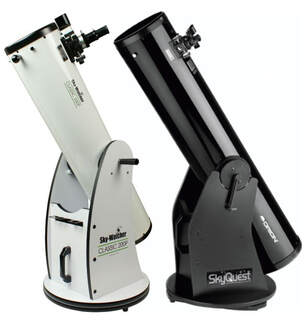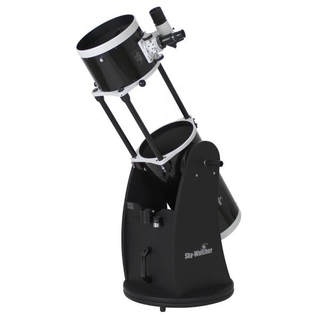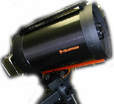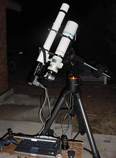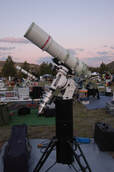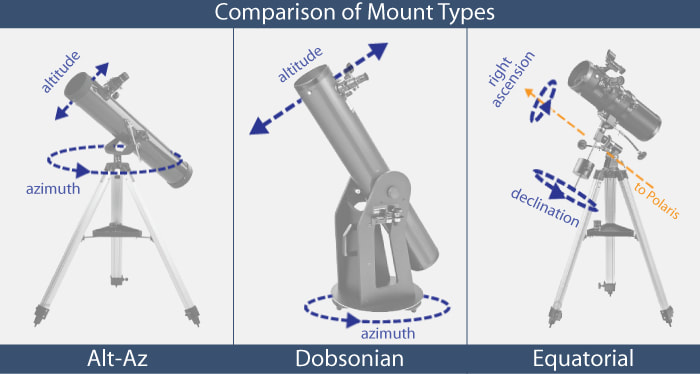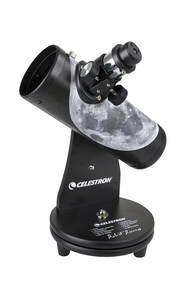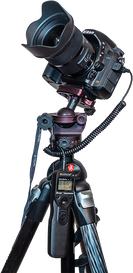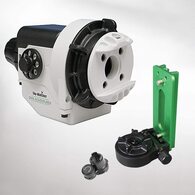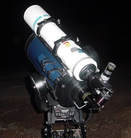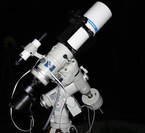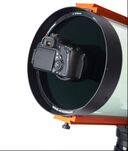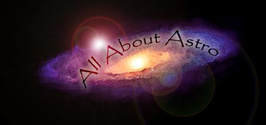A Telescope Buyer's Guide
- edited May 6, 2020Purchasing a telescope, especially your first scope, is a daunting task. There are just so many different types of scopes that do so many different types of things. Apos and Achros; SCTs and Maks; dobs and newts; RCs and CDKs...the choices can get overwhelming! But then, you must also consider how each "scope" or optical tube assembly (OTA) is mounted (see SIDEBAR: BASIC TELESCOPE MOUNT OPTIONS at right).
So instead of trying to explain to you what each type of scope does (a study for a later time), I think it's important to outline several qualities first. These should be on your mind when searching for your first telescope. In fact, these qualities are relevant to both the beginner and the expert, and serve as general rules to the hobby. Those five qualities are listed here, somewhat, in descending order of importance. In this Telescope Buyer's Guide, I'll talk a bit about each of these qualities and what it will mean to you. Plus, I'll give examples of scope designs that best meet those qualifications. I'll also discuss some other factors that play into any purchase decision. Finally, I will give recommendations based upon the kind of hobbyist you think you will be! Let's get started... APERTURE APERTURE size is important if you like deep sky objects (DSOs) like galaxies and globular clusters, or high resolution views of the planets. Likewise, aperture size is important for the fastest photographic speed and when trying to see faint stuff from light polluted skies. In other words, unless you want your scopes portable, APERTURE is ALWAYS important! APERTURE IS KING! To elaborate, bigger apertures gives a larger opening for collecting light, which is the FIRST job of a telescope. Most objects in the night sky are rather large and would be seen EASILY by the naked eye if they were bright enough. Thus, the larger the aperture of the scope, the more likely you will be able to see these objects, even at very low magnifications. Secondly, aperture serves to provide increased resolution, or detail in your views. While the quality of the atmospheric conditions, or "seeing," is the true limiting factor in this regard, most people will find that a good 10" scope will give great details for the majority of sky conditions. Only occasionally will larger aperture scopes perform at their theoretical resolutions, though make no mistake about it, they will certainly provide some exciting views during moments of excellent seeing! Of course, those living in good seeing areas, like on the coasts or atop a mountain, will be able to make best use of the resolution granted by large aperture scopes. But the fact that bigger scopes will accumulate more light makes them the best, and often only, choice for viewing faint DSOs, regardless of how good your seeing tends to be. The most common large aperture scope among amateurs is the reflector (aka, the Newtonian), mostly because it costs the least per inch of aperture when compared to other designs. Most observers of all levels of experience purchase these in the Dobsonian mounted-design because they give the most bang for the buck, sparing the customer the added cost of a good quality (or even bad) German equatorial mount. Even so, some people, especially astrophotographers, will opt to spend thousands of dollars on an equatorial tracking mount to use with these such optical tubes, known also as optical tube assemblies (OTAs). The larger the tube, the more robust and expensive such a mount becomes. Thus, the Dobsonian mount has become the most popular choice for general, deep sky observing. It's pure, raw aperture with nothing other extravagances to be purchased. The big negative when considering the Dobsonian (or "Dob") is that you are generally limited in the accessories you can include, especially if you desire the telescope to track automatically with the stars, or even give you electronic "goto" functionality. Often, these can be purchased as add-ons, however. Electronic encoders, servo drives, and tracking platforms, especially the nice dual-axis ones, do add a lot more to the total, but those are options for a later date. They are nice options to have! There are several makers of quality Dobsonian reflectors in sizes from 3" all the way up to 36". Prices vary according to aperture size, optical quality, mechanical quality, and features (especially for "truss" designs" and those that might embed electronics). Top notch makers include Obsession, Starmaster, Starsplitter, Teleport, and Mag-One, to name but a few. Good quality Dobs most commonly purchased are those made by larger companies such as Meade, Celestron, Orion, and Skywatcher. These include budget options and a variety of performance packages, "bundles, or "kits." However, Dobs - and reflectors in general - that have custom optics will demand the highest prices. If it comes with optics from the likes of Zambuto, Royce, or Pegasus then you can expect it to be a very nice telescope! But be prepared to spend money in the thousands of dollars for such quality. |
Sidebar: Basic Telescope Mount OptionsYou made it to the Orion Telescopes website and you are confronted with some options. Lots of them. You are confused!
But for now, you should know that a scope can come mounted in three different ways, represented below. Such scopes will typically be purchased with all you need to work it. But if we play, "which one is NOT like the other," then you'll certainly pick the one in the middle. This is the Dobsonian mounted scope. But in this case, you lose the game. The correct answer is the scope on the right. And what makes this different? It's the only scope where the optical tube assembly (OTA) can work separately from the mount on which it was purchased. The first two scopes require you to use it exactly as pictured. The first, a single fork-arm SCT, is a single unit, and must remain so for it's lifetime. The dobsonian? Same story. But the reflector on the right is purchased with a German Equatorial mount, known simply as an GEM or EQ mount. You purchased them together as a "bundle," but if you wanted, you could remove the OTA from the mount and use another OTA on it. Likewise, you could upgrade that mount to something "better" in the future, using the same reflector here. This aspect of telescope shopping is important to grasp, because as you advance in the hobby, regardless of the scope design, it's likely that you will be purchasing your instruments "al a carte," meaning that you might buy a nice EQ mount first, and then several other high-quality scopes (of varying types), and plan on interchanging them for whatever need you have on a given night. It's also the reason why something like a "Newtonian" reflector can come configured in so many different ways...perhaps mounted like a Dobsonian, riding atop an EQ mount, or even on a simple tripod. More importantly for you now, a scope is only as good as its weakest link. So when you consider your first scope, perhaps something mounted like the scope on the right, then you should know that the OTA might be terrific, while the mount be almost impossible to use. This, I hope, is something I can teach you to avoid. |
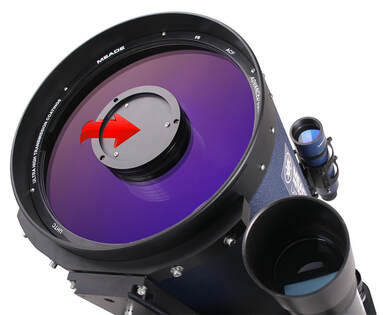 "Central Obstruction" - A Schmidt-Cassegrain (SCT) is a "folded" design, where light bounces back upon itself twice. This puts a secondary mirror in the middle of the front corrector plate to bounce light straight back to the eyepiece. This creates a "central obstruction" (red arrow) that light must pass around. While newtonians have this too, held in place with "vanes or a spider," it doesn't have to be nearly as large as that of the SCT. This is because light still has a 1/3 of its path remaining in the SCT, whereas in the "newt" it only has a little more distance to go. The effect of this is slightly "less" contrast in the view, since more of the light energy is concentrated into the "diffraction rings" of star's PDF. These are fancy words to say that non-obstructed designs like refractors are naturally higher contrast, while designs with the largest obstructions are worse, like SCTS, RCs, and CDKs, among others. That said, practically speaking, if its a good telescope, well-collimated with pristine optical figure, then it's only the most experienced visual observer will likely detect the difference.
"Central Obstruction" - A Schmidt-Cassegrain (SCT) is a "folded" design, where light bounces back upon itself twice. This puts a secondary mirror in the middle of the front corrector plate to bounce light straight back to the eyepiece. This creates a "central obstruction" (red arrow) that light must pass around. While newtonians have this too, held in place with "vanes or a spider," it doesn't have to be nearly as large as that of the SCT. This is because light still has a 1/3 of its path remaining in the SCT, whereas in the "newt" it only has a little more distance to go. The effect of this is slightly "less" contrast in the view, since more of the light energy is concentrated into the "diffraction rings" of star's PDF. These are fancy words to say that non-obstructed designs like refractors are naturally higher contrast, while designs with the largest obstructions are worse, like SCTS, RCs, and CDKs, among others. That said, practically speaking, if its a good telescope, well-collimated with pristine optical figure, then it's only the most experienced visual observer will likely detect the difference.
Another alternative when considering a telescope with larger apertures is the Schmidt-Cassegrains (SCTs). These are excellent choices because they are more compact and portable for any given aperture - light folds back on itself twice, shortening the tube - and often contains some wonderful electronic features such as automatic GOTO pointing, where you tell the scope where to go and it goes there all by itself. Thus, gadget "freaks" will certainly enjoy the ability to use their computers to control a large aperture scope. Of course, these added features come at an increase in price. Plus, they generally take a long cool-down time and are more susceptible to quality control issues because of the complexity of their electronics and mass-production techniques.
Some might say that the large central obstruction (see right) is a negative to the SCT design because of the general loss of contrast; however, my experience has been that contrast seems to fluctuate among samples of these scopes because of a variance in optical quality and poor user collimation from sample to sample. I've seen certain SCTs that exhibit some impressive, nicely contrasted views despite being obstructed. In my opinion, these design trade-offs are minor negatives for a system that provides such great versatility and power.
Meade and Celestron are the main players here; Meade with their LX-series OTA (typically in 8", 10", 12" and 16" sizes) and Celestron with some iteration of the classical C-8, C-9.25, C-11, and C14 (the numbers are their aperture sizes in inches). Both companies have EQ and fork mounted varieties, both in one and two fork-arm designs.
Finally, many of the world's best astrophotographers and professional observators will choose the Ritchey-Chretien Cassegrain (RC) or Dall-Kirkham Cassegrain (DK) as their large aperture scope of choice. These scopes generally combine the best qualities of all the other scope designs. But this doesn't come cheap! Expect to pay at least a $1000 per inch of aperture for such scopes. Likewise, the classical Cassegrain offers larger apertures, as does the BRC (Baker) and Mewlon (DK) telescopes from Takahashi. These are generally longer focal length designs and are still rather expensive.
While many of these advanced scopes aren't considered by beginner's from a budgetary standpoint, it's important to know of their existence, either to alleviate confusion or to allow you to start saving for one!
Regardless, when talking aperture, you will want at least 8" to 10" for visual observing of deep sky objects in dark skies. This is widely considered the point at which galaxy details begin to appear.
Most amateur astronomers will say that aperture size is the most important consideration when deciding on a scope. It's hard to disagree!
OPTICAL PERFORMANCE
Optics are typically the second consideration with a telescope, both in design and quality. From a design standpoint, the nature of the optics - mirror or lens, number of elements, focal length - determines the portability (size and weight) of a scope. Quality-wise, your choice of optics can mean sharpness of the view, fidelity of the color, and flatness of the field of view.
Some might say that the large central obstruction (see right) is a negative to the SCT design because of the general loss of contrast; however, my experience has been that contrast seems to fluctuate among samples of these scopes because of a variance in optical quality and poor user collimation from sample to sample. I've seen certain SCTs that exhibit some impressive, nicely contrasted views despite being obstructed. In my opinion, these design trade-offs are minor negatives for a system that provides such great versatility and power.
Meade and Celestron are the main players here; Meade with their LX-series OTA (typically in 8", 10", 12" and 16" sizes) and Celestron with some iteration of the classical C-8, C-9.25, C-11, and C14 (the numbers are their aperture sizes in inches). Both companies have EQ and fork mounted varieties, both in one and two fork-arm designs.
Finally, many of the world's best astrophotographers and professional observators will choose the Ritchey-Chretien Cassegrain (RC) or Dall-Kirkham Cassegrain (DK) as their large aperture scope of choice. These scopes generally combine the best qualities of all the other scope designs. But this doesn't come cheap! Expect to pay at least a $1000 per inch of aperture for such scopes. Likewise, the classical Cassegrain offers larger apertures, as does the BRC (Baker) and Mewlon (DK) telescopes from Takahashi. These are generally longer focal length designs and are still rather expensive.
While many of these advanced scopes aren't considered by beginner's from a budgetary standpoint, it's important to know of their existence, either to alleviate confusion or to allow you to start saving for one!
Regardless, when talking aperture, you will want at least 8" to 10" for visual observing of deep sky objects in dark skies. This is widely considered the point at which galaxy details begin to appear.
Most amateur astronomers will say that aperture size is the most important consideration when deciding on a scope. It's hard to disagree!
OPTICAL PERFORMANCE
Optics are typically the second consideration with a telescope, both in design and quality. From a design standpoint, the nature of the optics - mirror or lens, number of elements, focal length - determines the portability (size and weight) of a scope. Quality-wise, your choice of optics can mean sharpness of the view, fidelity of the color, and flatness of the field of view.
Sidebar: Basic Optical Tube Design
This gives rise to THREE different scope designs (above): one that uses mirrors (reflectors), one that uses lenses (refractors), and one that uses BOTH mirrors and lenses (catadioptrics or "cats"). All of these designs require some way of mounting it, which is the subject of the previous SIDEBAR.
One thing in common, regardless of the design, is that light has some distance to travel through the scope once it enters the scope. More precisely, from the moment it hits the primary element, whether a mirror (in reflectors and cats) or a lens (in refractors), the light begins to be focused toward its "focal point." This path from first contact (not including the corrector plate in an SCT) to the focal point is known as the focal length of the telescope. The focal ratio (or f-number) will be the overall focal length divided by the scope's aperture. In essence, this is a measure of how "steep" the cone of light is...or at what rate the light finds its focal point. With lenses, where light can only be bent, it must travel along the full length of the optical tube and out the other end. Thus, refractors are typically longer than most scopes at comparative aperture sizes. With concave mirrored primaries, both the reflector and cat scope (most notably SCTs), will fold the light back in the direction the light came to hit a secondary mirror placed in the center of the scope's aperture end (see the note above on "central obstruction"). In a typical newtonian reflector, that smaller secondary mirror is also concave, angled 45 degrees to bounce the light out the side, a short distance to the eyepiece. Compared to the refractor, the cutting-off of the light to the side of the scope as well as the typically short focal length of the primary mirror - lenses have typically longer focal lengths - means that the overall OTA of a newtonian reflector will often be shorter. A catadioptric, like a Schmidt (SCT) or Maksukov (Mak) Cassegrain, has a convex secondary mirror, which bounces light straight back toward the primary again, but this time the light "cone" is small enough to go through a hole in the primary and through the back of the telescope. The eyepiece awaits on the back side of the scope. In effect, the light has been twice folded back upon itself, which lends most "cats" the distinction of having a "folded" design. More importantly, it allows the tube to be greatly shortened, making the design far more compact. Similarly, because the secondaary is convex, it pushes light even further out of the back of the scope, meaning that longer focal lengths can be created with even shorter tube designs. The net result is an OTA that's about 1/5th shorter than the focal length of the instrument; hence, the compact design. We should be cautious about reflectors, however, since non-newtonian types of reflectors might do something different. For example, a classical cassegrain, Ritchey-Chretien (RC), and Dall-Kirkham (DK) telescope, while being twice folded like a Schmidt or Maksukov (Mak) Cassegrain, are actually reflectors since they lack a lens element or corrector plate. Interestingly, telescope-maker, Planewave, markets their "CDK" , or "corrected Dall-Kirkham." This design includes a pair of optical elements (lenses) just before the focal plane, making it a catadioptric design. Even more confounding, most any of the reflectors when used in imaging, especially RCs, will have optional field-flatteners/correctors sold as accessories, user-installed just before the focal plane. Similarly, TeleVue produces their Paracorr, which is a correcting "eyepiece" that goes ahead of the typical eyepieces to correct the "coma" aberrations natural to a newtonian design. What this goes to show is that the lines between the types of designs become very blurry in practical usage, since there is often a benefit to utilizing both lenses and mirrors as add-ons to traditional designs. Therefore, if you are confused by everything, then join the club! But rest assured none of that really matters right now, especially for the beginner. However, since you've undoubtedly seen all the lingo in your research of prospective scopes, this discussion gives some context about what it all means. Refractors come in both achromatic and apochromatic designs. This is necessary because refractive elements (lens) bend light differently at different frequencies. You can see this with a typical prism, where light is spread out into a rainbow across its different frequencies. As such, a telescope of a single lens element would be unable to focus all wavelengths at the same spot (a longitudinal error), meaning that red light (long waves) would be out of focus compared to the blue light (short waves). Similarly, there is a component of lateral error as well, meaning that a lens cannot necessarily assure that all of a specific wavelength is focused on the same focal plane, since any distortion or magnification variance within the lens is wavelength specific as well. This, of course, is a problem...one in which mirrored scopes do NOT have...a big advantage with reflectors. The solution for this "chromaticism" within refractors is three-fold: 1.) use more elements, 2.) use elements of higher quality glass (extra-low dispersion or ED glass), and 3.) make the focal length long enough to increase the "zone of focus." An achromatic refractor, typically with two elements (made of low-cost crown and flint glasses), is designed to bring light to focus in two broad wavelengths, typically red and blue. These "doublets" are easy to manufacture and are cost-effective, but they do not work to focus ALL the visible frequencies of light, most notably "violet." As such, on bright objects like the moon and planets, purple fringing is typically seen on the edges. This is called "spurious color" or "chromatic aberration." This is even more obvious if they make the scope too short. For this reason, many good achromatic doublets will be LONG, with f-ratios in excess of f/12 or f/15. Longer scopes (high f-ratios) increase the critical zone of focus or depth of field (see image below), making it possible for all visible waves, albeit dispersed, to be contained within that focal zone. Such scopes are good performers because they make best use of the design, working around its limitations. 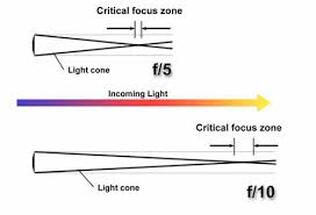 - image courtesy of Ron Wodaski's "The New CCD Astronomy" - image courtesy of Ron Wodaski's "The New CCD Astronomy"
Problematic for the first time scope buyer are those doublets known as "rich-field" refractors, which are made at f-ratios of f/5 to f/8. These, as you would expect, have abundant color fringing! If used on dim targets like star clusters and Milky Way vistas (hence the term "rich-field"), then there isn't too much issue, but if you hope to use such a scope to get good views of planets and the moon, then you will likely be disappointed. Likewise, if you bought the scope because of the "fast" f-ratios to do astrophotography, then you will be disappointed when most all the stars in the image, especially those at the edges of field, are a nightmarish purple mess.
As mentioned, color performance can be improved in refractors by adding more elements of glass, which of course raises the material and design cost of the instrument. This gives birth to the "triplet" refractor. Such a design is typically "apochromatic," meaning that it will be able to bring three broad wavelengths of light to focus, typically red, green, and blue. This should also bring "violet," and all other visible wavelengths, into focus as well. Though it should NOT be reasoned that all triplets are inherently apochromatic. Typically, true "apo" (or APO) performance requires the use of one or more of the elements being made of a special, extra-low dispension or ED glass. FPL-53 is the typical "ED" glass found in most of these refractor types, so if you have seen it listed in the specifications for an instrument, then now you know what it does! In some cases, a doublet-design can also be apochromatic in performance. Takahashi, in particular, once made a line of fine "fluorite" element doublet refractors (they still do in short production runs). Fluorite, which is a remarkably low dispersion glass that is grown in a lab, is now in too short supply to make these refractors in abundance; however, such fluorite doublets are wonderful, high-contrast instrument without a hint of spurious color. Takahashi also utilized fluorite in their triplets and quadruplets, which if you are lucky enough to have, are some of the best visual scopes on the planet. To my knowledge, the small volume-maker, TEC, and Takahashi (in a couple of short-production run scopes) are the only companies that still makes APO refractors with fluorite elements. Be careful of doublet refractors being marketed as ED APO scopes. A doublet with a single ED element of FPL-53 glass might not be truly apochromatic in the technical sense of the term, especially if the scope is on the "fast" side...let's say below f/7 or f/8. These scopes, because of their performance value are very attractive to buyers since they advertise APO performance at a bargain price. However, when compared side-by-side with a good APO triplet, it's easy to see that their color-fidelity is somewhat lacking. Today, because of consumer blow-back by those who know better, many distributors of these mostly Chinese-made "value" scopes have backed off the "ED APO" branding, choosing to advertise these doublets as "just" ED scopes. However, these scopes are a great middle ground, a good value option, particularly for those wanting a good photographic instrument and are willing to compromise just slightly on performance. To clarify another aspect of refractors, especially triplets, lens elements can be configured as either "air-spaced" or "oil-spaced." In the air-spaced design, lenses are only separated by a thin amount of air between them. This means light must pass through six surfaces before it exits the lens "cell." Each time it passes through an optical surface, from the dense glass to low density air, there is the possibility of internal reflections that can create a slight ghosting effect as you get farther from the center optical axis. This is fixed by using coatings on the surfaces of those elements, which most modern triplets do today. But when the elements ARE spaced with oil in between them, then the oil fills the gaps, making it behave as if the light passes only through two surfaces, the front of the first and the rear of the last. No need to use surface coatings, albeit it's much more difficult to assure both chromatic AND spherical aberrations are tamed. A good oil-spaced triplet is delight to use, high-contrast and very well corrected for aberrations, though it typically takes an advanced observer to appreciate it. It also comes to thermal equilibrium very quickly! An "oil-spaced" triplet is a rare breed today, since companies can get great performance in all aspects with the cheaper, air-spaced design. But companies like TEC still utilize the expensive "oil-spaced" design in their scopes. Having used their TEC 140FL, TEC 180FL, and TEC 210FL models, which are also "fluorite" triplets, these are the very best views I've ever had through any telescope at their given apertures. Other oil-spaced triplets that I've used in the past include the William Optics FLT-110 f/6.5 and various Astro-Physics models. Even today, for me, they represent some of the very BEST in optical triplet performance. Finally, another refractor design, also apochromatic, is the 4-element Petzval design. It typically utilizes a color-correcting lens pair up front, with one-or-both elements of fluorite or FPL-53 glass, and an additional "field-flattening" pair of elements in the back of the scope. Obviously expensive and wonderfully pristine in performance, it's typically the best refractor you can find if astroimaging is your desire. The Takahashi FSQ-series of scopes utilizes this design, as does the TeleVue NP-series of APO Refractors. Per inch of aperture, these scopes are the best optical instruments there is when you demand the best color-correction combined with the ultimate in field-flatness. Both traits are highly desirable when imaging with today's larger sensors, so much so that most people purchase "field-flatteners" to be used with the already pristine doublet and triplet apos. |
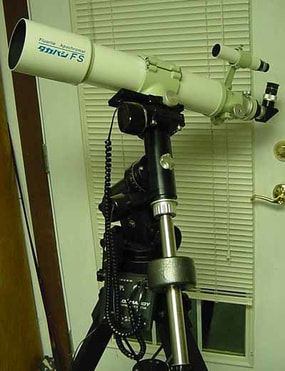 Portable? Don't forget the mount! Shown is a Takahashi FS-78 on a Losmandy GM-8 mount, taken around 2002. APOS are immanently portable, but once you account for a good quality mount, especially for photography, you can get a bad back really fast...and of course, a mount doesn't fit in an airplane carry-on. In this case, the GM-8 is actually one of the more portable mounts you'll find. Quick tips...mailing you gear ahead of you OR checking them as baggage on your flight are good ways to have your imaging cake and eat it too. Portable? Don't forget the mount! Shown is a Takahashi FS-78 on a Losmandy GM-8 mount, taken around 2002. APOS are immanently portable, but once you account for a good quality mount, especially for photography, you can get a bad back really fast...and of course, a mount doesn't fit in an airplane carry-on. In this case, the GM-8 is actually one of the more portable mounts you'll find. Quick tips...mailing you gear ahead of you OR checking them as baggage on your flight are good ways to have your imaging cake and eat it too.
Anything bigger than 6 or 7 inches in any refractor becomes extremely large, heavy, and expensive, especially if its an APO. I have experience with many larger APO refractors, including a TMB 203mm; and both the TEC 180FL and TEC 200FL fluorite refractors. The views through the TECs (which are air-spaced triplets) are some of the best views I've ever witnessed through a telescope. I also have regular access to a 15" f/12 doublet refractor with D&G optics (a 19 foot long refractor). Whereas the views aren't particular well color-corrected on bright objects, the 15" refractor at the Comanche Springs Astronomy Campus in Crowell, Texas (3RF) definitely makes globular clusters look like grains of fine sugar!
But not all high quality refractors are expensive. Many makers now produce exceptionally nice, small APOs in the 2" to 4" range that can be had for very reasonable amount of money, perhaps in the area of $500 to $1200.. Such models are highly recommended for the aspiring astrophotographer who is on a tight budget, or the informed beginner who is serious about "doing it right." Most of us who own APOs settle for scopes in the 3" or 4" range because of price considerations and portability concerns. Of course, we eventually yearn for more. But apochromatic refractors, and to a lesser extent achromatic refractors (achros), have such high contrast due to their quality optics, lack of central obstruction, high color correction (not with an achros), anti-reflective coatings, and internal baffling that they tend to show objects in similar detail to that of scopes slightly larger in size. They even seem to have the ability to cut through nights of poor seeing to give steady views when you wouldn't be able to see anything otherwise, though this is perhaps more of a function of their smaller aperture sizes yielding less resolution. Beyond refractors, large Newtonians reflectors (FYI, a Dobsonian is a type of Newtonian) with great optics will yield uncompromised views. Newtonians, as well as APO refractors, will have wide fields of view (in smaller focal ratios) providing the luxury of seeing more of the sky at once. But many will find that such large reflectors are too cumbersome when compared to the size/performance of a refractor. Plus, big reflectors are difficult to keep centered on planets unless they are equatorially mounted, configured with motors, or sit on a tracking platform. Thus, for pure planetary performance, I recommend the apochromatic refractor (if not the more capable planetary imaging scope, the SCT). But don't think for one second that reflectors take second billing to refractors. A large newtonian with terrific optics tracking on a planet like Jupiter or Saturn is a mind blowing experience. If the atmospheric "seeing" is stable, then crank up the power (over 500x) and you might have the greatest eyepiece view of an object that you'll ever experience! The aforementioned Maksukov-Cassegrains (Maks) are also good alternatives when looking for scopes of excellent optical performance. The legendary 3.5" Questar is the classic example, but most of the major telescope makers now produce some model of Mak-variant. Costing as much, or more, than APO refractors, the Questar is the prime example of how good these scopes can be, though it is an outlier from the standpoint of price - most are quite affordable by comparison. The Meade and Celestron series of Maks comprises the larger market-share, though Orion, Explore Scientific, and Sky-Watcher now produces them as well. Maks are often overlooked, but they too have really nice optical performance chiefly because the design employs a smaller central-obstruction for higher contrast views. Moreover, these scopes often come packaged with fork mounts and the luxury of GOTO drives, just like the SCTs - albeit I feel that these features are often under-utilized in the smaller aperture sizes (a source of criticism among amateurs). After all, what good is an object-library of 40,000 items if your 3" scope will only show you a few hundred of them from your light polluted site? Maks do have longer focal lengths than normal scopes (which is why the central obstruction is so small). This makes them excellent planetary scopes due to the fact that they are more powerful with any given eyepiece and, of course, due to their higher contrast views when compared to other obstructed designs. Astrophotographers of deep-sky targets would say that Maks do not make good imaging scopes - though they are wonderful for bright targets like the moon and planets. I would concur with this opinion as a general statement, but being f/15 does not negate a Mak-design from taking great images IF you are matching the camera's pixel size to the focal length of the instrument. At that point, there is no performance disadvantage despite the "slower" speed. Many people will also say that the narrow fields of view are also a real negative to these Mak designs, but I'd tend to disagree. Wide-field eyepieces and focal reducers are available to give you wide enough views, if needed. Lastly, I feel that the only remaining negative to these scopes would be their general quality, especially their enclosures, and the increased likelihood that the scope's electronics gives it more reasons to find its way into the repair shop. PORTABILITY The third consideration when looking to buy a scope is PORTABILITY. This could be considered the most important factor, especially if you need to travel to dark sky sites or desire quick setup observations (see this article on the importance of dark skies for viewing here). Likewise, many of us struggle with larger gear as we age! Scopes bigger than 10" are very difficult to transport (SCTs due to the weight and reflectors due to the size), which is a big reason why many of these scopes never get used. So, this must be considered in any purchase decision. For example while being a great performer, a 16" Dobsonian (non-truss variety) cannot be carried in anything smaller than a cargo plane (a little exaggeration, but not far off). Likewise, my old 10" LX-200 SCT (yes, I still have it) weighs somewhere around 50 lbs., not including the huge, heavy tripod and wedge (optional). 8" in aperture is generally the largest scope among reflectors and SCTs that most would considered "portable." Of course, "portability," in the mind of most advanced astronomers, is determined by their passion. After all, it's amazing how "portable" something becomes when you are sufficiently motivated! Otherwise, larger scopes are best when you can set them up permanently at home, either in your own observatory or rolled out from the garage. Of course, this would require reasonably dark skies to begin with, something that a growing majority of people no longer have. Because of this, it becomes necessary to consider scopes that can be toted easily to darker sky sites. Some examples are most Maks, smaller Dobsonian reflectors, and smaller refractors on alt-az or light-weight German equatorial mounts (see the SIDEBAR: ALT-AZ VS. EQ below for a distinction between these mounts). These can be good first telescopes, especially considering their lower prices. A person who buys a scope that never gets used will probably leave the hobby prior to finding out how truly wonderful it is. Lack of portability is a major reason why. Therefore, quite often the best scope for YOU is the scope you will use most often. QUALITY
Another important concern, quality, usually scales inversely with portability - high quality often equates to heavier, well-built gear. While we've already discussed the necessity of quality optics, the other components such as mounts, focusers, tubes, mirrors/lens, etc., can make or break your enjoyment of the hobby. Because many scopes are mass-produced, the potential for sub-par quality, or inconsistent quality controls, are always there. This could come in the form of poor optics, breakable plastic parts, and limited or inaccurate electronics, to name just a few. For this reason, there is a central truth to astronomy, "YOU GET WHAT YOU PAY FOR..." As with anything else in life, if you put money into it you'll be purchasing a certain amount of quality, and the more you pay, the more quality you get! Scopes less than $300 have the potential to be real pieces of excrement, the exception being some smaller sized reflectors. Some makes like Tasco, Jason and Bushnell, along with the consumer-lines of Meade and Celestrons found at places like Wal-Mart, should be avoided at all costs. These classes of scopes might be suitable for people with low budgets, especially if their expectations of the scope match their budgets, but generally speaking, a good pair of binoculars will likely be the wiser purchase. Few scopes have perfect track records where quality is concerned. For example, some of the "all-in-one" types of scopes suffer from poor workmanship in the form of mickey-mouse gears and plastic castings, even though the optics remain of good quality. And even some of the flagship models from these makers will still have plastic gears. User reports help the most when determining which scopes (and mounts) have the best quality. You should understand that "quality" makes itself most evident in the mount. Remember this rule: A GOOD SCOPE WITH A BAD MOUNT BECOMES A BAD SCOPE. Shaky or undersized mounts should be avoided at all costs. As much time should be used in considering the mount as the scope itself, and if you are interested in astrophotography, the mount is by FAR the most important component in the system. If you are going to buy quality, make sure it comes in the mount! |
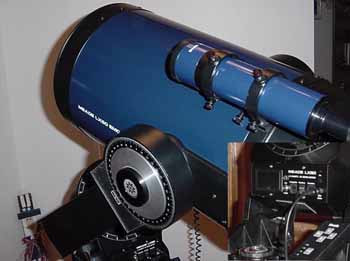 My First Telescope - In 1997, I purchased this 10" Meade LX-50 Schmidt-Cassegrain, or simply "SCT." Typically more expensive than a "first" telescope, they are the KING of flexibility, serving as excellent visual instruments, imagers, and even a tracking platform for piggybacked scopes or lenses. For the gear-head or tech-guy who fancies a mix of fun, the SCT is really hard to beat without totally breaking the bank.
My First Telescope - In 1997, I purchased this 10" Meade LX-50 Schmidt-Cassegrain, or simply "SCT." Typically more expensive than a "first" telescope, they are the KING of flexibility, serving as excellent visual instruments, imagers, and even a tracking platform for piggybacked scopes or lenses. For the gear-head or tech-guy who fancies a mix of fun, the SCT is really hard to beat without totally breaking the bank.
FLEXIBILITY
You might need to consider FLEXIBILITY when considering your scope. You'll know more about this trait after you do your homework and you'll likely understand its importance after a year or two in the hobby. For example, if you decide that you want to do astrophotography, then you might want a scope that has the versatility of both a good visual and astropix platform. SCTs are the masters of versatility, designed to be accommodated with tons of options and enhancements that make these scopes extremely powerful in the hands of even the most casual of observers.
Be careful with some of the extras that come with computerized scopes. While GPS or auto-set capabilities are pretty much standard equipment today, they generally provide very little in the way of excess flexibility. After all, if you only use the scope at home, then GPS really only helps on the first night of observing.
Also, smaller scopes are great because they are highly portable, but you lose some flexibility because their aperture sizes make them less optimal scopes for a wide-variety of observing. So, you must strike a balance with other features you might feel are important.
Generally speaking, the more money you pay for a scope, the more versatile or flexible it becomes, until the point where gear becomes more specialized. This is especially true of astrophotography setups, where scopes and mounts are designed with only that in mind. For this reason, many amateurs will own more than one such scope, each of which has the purpose of doing something different, yet doing it exceptionally well! Thus, we would be more likely to purchase individual pieces to accomplish multiple tasks.
Most beginners desire to see a bit of everything, and do a bit of everything with their first telescopes, making FLEXIBILITY a higher priority than it probably should be. For example, despite the highly recommended 8" Dobsonian reflector being a really great purchase, there is a possibility that you'll be a little disappointed at how "plain" it is. It lacks a lot of the bells and whistles you'll find with other electronic scopes. It's also a poor choice for astrophotography. But that doesn't mean it's not the scope you should buy for your first instrument!
Likewise, those that purchase a small, rich-field refractor will be very disappointed with the views they get on planets. Rich-field refractors simply aren't designed for anything other than wide-field views of the Milky Way and star clusters from darker skies. So, do NOT over-prioritize flexibility in an instrument...you cannot expect a small investment to be good at a TON of things!
Therefore, as a beginner, you should probably temper your expectations a little bit and purchase a good telescope for visual use only, since the more versatile scopes are also more complex, not to mention more expensive. Allow yourself some time before you look for versatility in a scope...save such things for your second one!
You might need to consider FLEXIBILITY when considering your scope. You'll know more about this trait after you do your homework and you'll likely understand its importance after a year or two in the hobby. For example, if you decide that you want to do astrophotography, then you might want a scope that has the versatility of both a good visual and astropix platform. SCTs are the masters of versatility, designed to be accommodated with tons of options and enhancements that make these scopes extremely powerful in the hands of even the most casual of observers.
Be careful with some of the extras that come with computerized scopes. While GPS or auto-set capabilities are pretty much standard equipment today, they generally provide very little in the way of excess flexibility. After all, if you only use the scope at home, then GPS really only helps on the first night of observing.
Also, smaller scopes are great because they are highly portable, but you lose some flexibility because their aperture sizes make them less optimal scopes for a wide-variety of observing. So, you must strike a balance with other features you might feel are important.
Generally speaking, the more money you pay for a scope, the more versatile or flexible it becomes, until the point where gear becomes more specialized. This is especially true of astrophotography setups, where scopes and mounts are designed with only that in mind. For this reason, many amateurs will own more than one such scope, each of which has the purpose of doing something different, yet doing it exceptionally well! Thus, we would be more likely to purchase individual pieces to accomplish multiple tasks.
Most beginners desire to see a bit of everything, and do a bit of everything with their first telescopes, making FLEXIBILITY a higher priority than it probably should be. For example, despite the highly recommended 8" Dobsonian reflector being a really great purchase, there is a possibility that you'll be a little disappointed at how "plain" it is. It lacks a lot of the bells and whistles you'll find with other electronic scopes. It's also a poor choice for astrophotography. But that doesn't mean it's not the scope you should buy for your first instrument!
Likewise, those that purchase a small, rich-field refractor will be very disappointed with the views they get on planets. Rich-field refractors simply aren't designed for anything other than wide-field views of the Milky Way and star clusters from darker skies. So, do NOT over-prioritize flexibility in an instrument...you cannot expect a small investment to be good at a TON of things!
Therefore, as a beginner, you should probably temper your expectations a little bit and purchase a good telescope for visual use only, since the more versatile scopes are also more complex, not to mention more expensive. Allow yourself some time before you look for versatility in a scope...save such things for your second one!
SUMMING IT ALL UP
We have outlined several things to consider before purchasing a scope, categories that EVERYBODY looks at when evaluating which scope meets their needs. Of course, with a true beginner, seldom do you know what your needs are! This is why, after all, choosing a scope can be so difficult when you first start in this hobby.
Below I have ranked scope types according to each category on a 1-10 scale. 1 is "low" and 10 is "high."
We have outlined several things to consider before purchasing a scope, categories that EVERYBODY looks at when evaluating which scope meets their needs. Of course, with a true beginner, seldom do you know what your needs are! This is why, after all, choosing a scope can be so difficult when you first start in this hobby.
Below I have ranked scope types according to each category on a 1-10 scale. 1 is "low" and 10 is "high."
Dobs |
SCTs |
Maks |
APOs |
RC/CDK/Cass |
Achros |
Newts |
Fast Astrographs |
Category Summary |
|
Aperture |
10 |
8 |
5 |
2 |
8 |
3 |
9 |
7 |
Dobs are the best way to have massive aperture outside of a permanent enclosure (observatory), where the "folded" designs rule. Short newts (on an EQ mount) are practical as well. |
Optical Performance |
5 |
5 |
6 |
10 |
9 |
4 |
6 |
5 |
The least obstructed design combined with the best quality in optics makes APOs the easy winner. |
Portability |
5 |
4 |
10 |
8 |
3 |
8 |
1 |
5 |
Maks for all-around portability; small APOS for airline travel (especially on alt-az mounts); larger refractors are not as portable as one might think; Dobs are portable for their aperture size. |
Quality |
7 |
5 |
4 |
9 |
10 |
3 |
5 |
5 |
The imaging designs (RC, CDK, BRC) and other classical types of casses and DKs must be high quality to perform. There is some variance with cheaper APOs, but most are generally solid. Larger custom-dobs can be special. |
Flexibility |
3 |
8 |
3 |
6 |
2 |
2 |
5 |
1 |
SCTs are the jack-of-all-trades scope; bigger APOs are versatile for quality of visuals, planetary-use, and imaging. |
Bang for the Buck |
10 |
6 |
5 |
3 |
2 |
5 |
8 |
4 |
Massive aperture for low cost is the Dob's trademark; SCTs are reasonably priced for their versatility; chinese "value" APOs and newts can be good performers as well. |
DSO Imaging |
1 |
8 |
2 |
8 |
10 |
2 |
7 |
8 |
For single objects, folded designs win the day; for wide-fields, nothing beats an APO refractor short of a fast astrograph like a Celestron RASA or Tak Epsilon. Short newts the budget option for a highly capable DSO setup. |
Lunar/Planetary Imaging |
5 |
9 |
9 |
5 |
5 |
2 |
6 |
3 |
The world's greatest amateur planetary images are taken with SCTs. Big aperture dobs give good views until you raise the power and watch them scoot too quickly across the eyepiece. Tracking scopes are preferred. |
Resale Value |
4 |
3 |
3 |
7 |
8 |
2 |
5 |
5 |
APOS return most of their value upon resale, especially if you purchase used in the first place. |
Wide Field imaging |
1 |
2 |
1 |
10 |
2 |
3 |
5 |
8 |
Bigger astrographs can't go exceptionally wide like an APO can, but they are amazing for wide-fields. Epsilons are tricky. APOS are the overwhelming, majority choice here. |
Cost |
5 |
6 |
3 |
9 |
10 |
2 |
5 |
7 |
Scopes built for imaging or those with custom optics (especially with multi-elements) are the most expensive. |
Ease of Use |
8 |
6 |
6 |
5 |
2 |
4 |
4 |
3 |
Dobs are the easiest to use, followed by any small scope on an alt-az mount. Other scopes typically come with electronics that can raise the learning curve. Same with EQ mounts. |
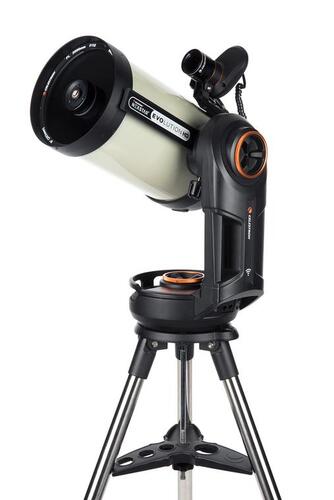 For the Techie Guy - Celestron's Nexstar Evolution 8" with Starsense is a lot of scope for the money. $2300 isn't cheap, but this wifi-equipped scope not only can be controlled via your phone, it sets itself up completely. While I always advocate learning the sky the old fashioned way, it's hard to argue with a scope like this that takes a ton of frustration out of the learning process. Buy the scope...bring binoculars to learn where they are.
For the Techie Guy - Celestron's Nexstar Evolution 8" with Starsense is a lot of scope for the money. $2300 isn't cheap, but this wifi-equipped scope not only can be controlled via your phone, it sets itself up completely. While I always advocate learning the sky the old fashioned way, it's hard to argue with a scope like this that takes a ton of frustration out of the learning process. Buy the scope...bring binoculars to learn where they are.
- THE TECHIE GUY - I am a guy. I like toys. Those two traits are not mutually exclusive. If you are anything like me, you probably came across this really cool looking telescope when you were walking past the "nature store" at the mall. Or maybe you visited a local star party one night and saw somebody's electronic telescope racing across the sky at the push of a button? Or perhaps you like the thought of hooking telescopes to computers and robotic-control of your observations?
There is no better time than NOW to get into the hobby for "The Techie Guy." The way advanced amateurs do astronomy today has been transformed over the last two decades by the technology that is available to us "off the shelf" - technology that is actually quite reasonably priced.
For this type of person then, it's really hard to beat a Schmidt-Cassegrain Telescope (SCT) in the 8" to 11" aperture size. These instruments do just about everything you can imagine. They provide GOTO slews to thousands of targets in the night sky to be viewed through either an eyepiece, recorded on video, or snapped with a camera. At a $2000 to $5000 price point, depending on size, it's nothing to sneeze at! But then again, you recently dropped three-grand on a gaming PC, so why the heck not!
Also, the scope shown at left, and many other scopes that are electronically-equipped, will have a dedicated jack for a serial, cable connection to a controlling PC or laptop. Some, like the Evolution, even have WiFi capability to a phone or tablet device. This is also true of German EQ mounts (GEMs) that you might consider for imaging.
These connections lead for greater infrastructure possibilities, whereas these scopes become the centerpiece of an actual robotic observatory or an unattended, remote-controlled setup. Whether its a backyard setup controlled from the comfort or a warm living room or an observatory located hundreds of miles away, this connectivity leverages powerful software to control the scope, camera, and any other accessories needed for hands-free operation, such as guiding cameras, auto-focusers, dew-heaters, and cooling fans. - THE BEGINNING ASTROIMAGER - A true beginner typically does not buy a telescope specifically to take pictures; however, a "beginning astroimager" is also full of questions regarding what gear they should buy.
To help with these crucial decisions, you should know one principle, first and foremost...the longer the focal length of your scope/lenses, the more difficult it is. And it's not a linear relationship either; the difficulty goes up exponentially with focal length. This puts a strong premium on the mount, which in turn puts a strong demand on your pocketbook!
It should probably be stated that a beginner to astroimaging should probably get some experience using their own DSLR with camera lenses, either on a tripod or a small "tracker" mount. But once you have done this, an imaging telescope becomes inevitable.
Over the years, at some point, I have recommended SCTs (especially with small refractors and lenses piggybacked atop) and EQ-based Newtonians for beginners. Then, I decided that smaller apochromatic refractors with mid-range EQ mounts was probably the best bet.
Any of these would be good advice, especially any purchase that includes a solid EQ mount.
Today, I have concluded that there is no single best choice. Instead, I have five suggestions, sequential steps toward success ...see below right.
